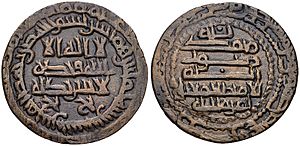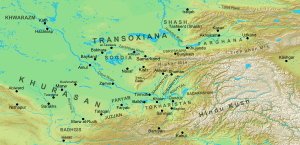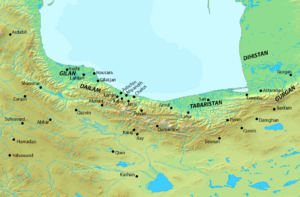Ismail Samani facts for kids
Quick facts for kids Ismail Samaniاسماعیل سامانی |
|
|---|---|

Coinage of Isma'il ibn Ahmad, Usrushana mint. Dated AH 280 (893-4 CE).
|
|
| Amir of the Samanid Empire | |
| Reign | August 892 – 24 November 907 |
| Predecessor | Nasr I |
| Successor | Ahmad Samani |
| Born | May 849 Farghana |
| Died | 24 November 907 Bukhara |
| Burial | Samanid Mausoleum, Bukhara |
| Issue | Ahmad Samani |
| Dynasty | Samanids |
| Father | Ahmad ibn Asad |
| Religion | Sunni Islam |
Ismail Samani (born May 849 – died November 24, 907) was a very important ruler, known as an amir, of the Samanid Empire. He ruled the regions of Transoxiana (from 892 to 907) and Khorasan (from 900 to 907). During his time, the Samanids became a very strong and powerful empire. Ismail was the son of Ahmad ibn Asad and a descendant of Saman Khuda, who started the Samanid family. Saman Khuda changed his religion from Zoroastrianism to Islam.
Contents
Who Were the Samanids?
The Samanid family came from a place called Balkh. They spoke and supported the Persian language. They also used many old Persian titles from before Islam. This helped them show that their rule was a continuation of the great Sasanian Empire.
Ismail's Early Life and Rise to Power
Ismail was born in Farghana in 849. His brother, Nasr I, became the Samanid ruler in 864 or 865. Nasr sent Ismail to take control of Bukhara, a city that had been badly damaged by attacks. The people of Bukhara were happy to see Ismail, hoping he would bring peace.
Soon, Ismail and his brother Nasr had a disagreement about tax money. A fight followed, and Ismail won. Even though he was now in charge, he didn't officially remove his brother. He stayed in Bukhara because the Caliph (the leader of the Muslim world) had formally recognized Nasr as the ruler of Transoxiana. Ismail respected this. He continued to recognize Nasr as the official ruler until Nasr died in August 892. After that, Ismail officially took power.
Ismail's Reign and Achievements
Making the Empire Stronger

Ismail worked hard to expand the Samanid influence to the north and east. He also made his control stronger in other areas like Kirman, Sistan, and Kabul. Ismail helped the economy grow and built a powerful army. His capital city, Bukhara, became one of the most famous cities in the Islamic world. Ismail brought many scholars, artists, and legal experts to the region. The first translation of the Qur'an into Persian happened during Samanid rule. Many mosques and religious schools were built, helping Sunni Islam to grow.
In 893, Ismail captured the city of Talas, which was the capital of the Karluk Turks. He took many slaves and animals. A Christian church there was also turned into a mosque. He also took control of the Principality of Ushrusana, extending Samanid power to the Syr Darya river. Ismail and other Samanid rulers helped spread Islam among the local people. About 30,000 tents of Turks became Muslims. His campaigns kept the heart of his empire safe from attacks.
Facing the Saffarids
Even after his brother Nasr died, the Caliph had not yet formally recognized Ismail as the ruler of Bukhara. So, another powerful ruler, 'Amr-i Laith of the Saffarids, asked the Caliph to give him control of Transoxiana. However, the Caliph, Al-Mu'tadid, sent Ismail a letter. He told Ismail to fight 'Amr-i Laith, whom the Caliph saw as a rebel. The Caliph even said he prayed for Ismail, calling him the rightful ruler of Khorasan. This letter made Ismail determined to fight the Saffarids.
The two armies met in Balkh, in northern Afghanistan, in the spring of 900. Ismail's army was much smaller, with 20,000 horsemen against 'Amr's 70,000. Ismail's soldiers were not as well-equipped. But despite fierce fighting, 'Amr was captured. Some of his own troops even switched sides to join Ismail. Ismail sent 'Amr to the Caliph. The Caliph then officially gave Ismail control over Khorasan, Tabaristan, Ray, and Isfahan.
Taking Control of Northern Iran
Ismail decided to use the Caliph's grant to his advantage. He sent an army to Tabaristan, which was ruled by the Zaydids. Ismail's army defeated the Zaydids, and their leader, Muhammad ibn Zayd, was captured and died. With the Zaydid leaders captured, the Samanids took over the province. This Samanid victory brought back Sunni Islam to the area.
However, Ismail's general, Muhammad ibn Harun, soon rebelled. Ismail had to send an army, led by his son Ahmad Samani, to northern Persia in 901. They forced Muhammad to flee. The Samanid army also conquered other cities like Ray and Qazvin. Ismail then made his cousin, Abu'l-Abbas Abdullah, the governor of Tabaristan.
Ismail continued to send gifts to the Caliph, as was the custom. But he did not pay tribute or taxes. This meant he was an independent ruler, even though he never took a title higher than amir.
Death and Legacy
Ismail died on November 24, 907, after a long illness. His son, Ahmad Samani, became the next ruler. Ismail was known for giving away huge amounts of treasure and riches to others, keeping very little for himself.
Ismail is remembered as a skilled general and a strong ruler. Many stories about him are found in old Arabic and Persian writings. Because of his successful campaigns in the north, his empire was so safe that the defenses of Bukhara and Samarkand were not needed. However, this later caused problems. At the end of the Samanid dynasty, when they were under attack, they greatly missed those strong walls.
A historian from Bukhara wrote in 943 that Ismail:
- "Was indeed worthy and right for padishahship. He was an intelligent, just, compassionate person, one possessing reason and foresight...he conducted affairs with justice and good ethics. Whoever treated people badly he would punish...In state matters he was always fair."
The famous scholar Nizam al-Mulk also wrote that Ismail:
- "Was extremely just, and his good qualities were many. He had pure faith in God and he was generous to the poor – to name only one of his notable virtues."
After the end of the Soviet Union, Ismail's importance was brought back to life in the new country of Tajikistan. He is shown on the SM 100 banknote. Also, the highest mountain in Tajikistan was renamed after Ismail. This mountain was once called "Stalin Peak" and "Communism Peak," but it is now known as the Ismoil Somoni Peak.
See also
 In Spanish: Ismail Samani para niños
In Spanish: Ismail Samani para niños
- Al-Sawad al-A'zam
- Ismoil Somoni Peak
- Somoni



